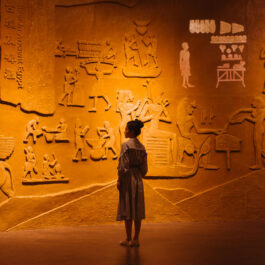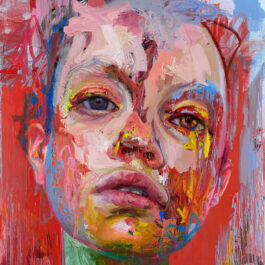Each month, American Express Essentials highlights one definitive literary work, old or new, and across any and all genres. The only determinant is quality: a book that makes life more vivid, more inspiring – a gifted piece of work you want to share. An absolute must-read.
Up this month is a riveting tale of music, peace, love, art and feminism: American cartoonist Trina Robbins’ memoir, Last Girl Standing.
While Trina Robbins may not exactly qualify as a household name, she is something of a legend for a certain subset of comic and cartoon fans. An incredibly multifaceted individual, Robbins has left an indelible mark as a writer, fashion radical, feminist, pioneering cartoonist, editor and more, contributing to editions of Wonder Woman, among many other culturally significant publications. Last Girl Standing is her memoir – a surprising rollercoaster ride of a book that catapults readers from 0 to 100 in the blink of an eye.
In less than 50 pages, Robbins candidly details her astonishing transformation from shy kid to college dropout, eventually embracing the unexpected role of a nude pin-up model – and that’s just for starters. The narrative, far from predictable, then delves into a captivating array of once-in-a-lifetime tales (for anyone other than Robbins, clearly), with each chapter revealing a new facet of her remarkable life. For Robbins, the extraordinary becomes the ordinary, and her book becomes a testament to a life lived on the fringes, where surprises abound and conventionality takes a back seat to the marvellous twists and turns of her unique journey.
The star-studded list of cameos in this book reads like a who’s who of major cultural icons, from Bob Dylan and Jim Morrison to Andy Warhol, Lou Reed and Joni Mitchell. Robbins doesn’t just recount these encounters; she paints a vivid picture of a life that most people can only dream of.
Her journey unfolds across the vibrant landscapes of the Los Angeles Sunset Strip in the 1960s, the (kind of seedy) Lower East Side of New York City in the 1970s, and the bohemian haven of San Francisco in the 1980s. At every turn, it becomes clear that we’re dealing with a woman who didn’t just witness, but actively participated in the seismic shifts of American culture during the ’60s – from the music that defined an era to the countercultural upheaval of the hippie movement, and everything in-between. Robbins captures the spirit of the times in evocative detail as her narrative weaves through the complex tapestry of decades, while her insights into her firsthand experiences in the underground comix movement add another layer to the extraordinary mosaic of her life.
This is a walk down memory lane like no other. As she says in her own words: “Have I mentioned that everybody was so young?” Indeed, youth is the essence of this book.
Elevating Last Girl Standing to an even more youthful, fast-paced and utterly engrossing realm are the author’s alluring illustrations and comics, as well as the occasional inclusion of newspaper clippings or images that bring specific events alive. These visual elements infuse the narrative with a dynamic energy that maintains the book’s vivid, agile style. Robbins seamlessly weaves her artistic prowess into the storytelling, and the combination of compelling (and easy-to-follow) prose and arresting images transforms the book into an undeniable page-turner – each chapter a visual and literary adventure. The synergy between words and illustrations not only enhances the storytelling but also underscores the richness of her life, making this a vibrant recollection of experiences that will resonate not only with the seasoned reader who lived through her times, but also with a younger audience in search of a fresh new read.
What perhaps resonates most profoundly in Last Girl Standing is Robbins’ gradual immersion into, and eventual embrace of, the feminist movement, which occurs – according to her own words – in the intimate fabric of her life. No grand, earth-shattering events define her feminist awakening (although they play a role). Instead, it happens in the quieter, more personal moments when the men in her life made her feel unseen, ignored or unimportant solely because she is a woman. It’s her fellow cartoonists saying she “has no sense of humour” for denouncing the blatant sexism in R. Crumb’s comics. It’s her friends skipping over her when introducing people in work-related settings (“If I did manage to wangle my way into a party, I was not introduced.”). It’s the unsettling reality of Charles Manson and his brand of radical misogyny gaining a following within her social circle. It’s the women heading into the kitchen after dinner while the men linger in conversation. It’s becoming disenchanted with the unrestricted sexual dynamics of her time when she realises her partners offer next to nothing in return (“The new sexual freedom I had believed in was a lie: women were simply providers of free sex, and it was uncool to ask for commitment.”). It’s the father of her child refusing to parent or share basic household chores (“I, who had naively believed in peace and love, was beginning to realise that there was a lot of hostility in these guys.”) In some ways times have changed, yet in others they remain the same.
All these nuanced experiences punctuate Robbins’ narrative, highlighting the personal struggles and societal challenges that fuelled her journey towards feminism, enriching the book with a deeply introspective and thought-provoking layer, without ever reading as preachy.
For anyone deeply immersed in the world of comic books, the joy of Last Girl Standing extends beyond the story of Robbins herself. The book treats readers to the appearances of not only Trina’s fellow underground cartoon artists, but also iconic figures like Art Spiegelman and Marvel’s Stan Lee. A brief mention of Disney’s original cartoonists, ‘the Nine Old Men’, is only the cherry on top.
Trina’s insider tales from the industry, coupled with sporadic ‘how-to’ insights scattered throughout the book, serve as a treasure trove for comic enthusiasts. These glimpses into the comic book world, coupled with Robbins’ firsthand accounts, provide a rich and engaging perspective that is bound to captivate readers with a significant interest in comics, whether niche or mainstream.
A vivid and nuanced portrait of the life and character of Trina Robbins, Last Girl Standing will leave readers with indelible impressions. Beyond the anecdotes, the celebrity encounters, and the cultural and industry insights, the book relates a highly personal journey that unveils the essence of Robbins herself. It’s a testament to her resilience and creativity, as well as the evolution of her identity against the dynamic backdrop of the times. Readers, whether familiar with her work or encountering her for the first time, will undoubtedly take away a multifaceted understanding of Trina Robbins, the artist, the feminist, the woman behind the remarkable tales – making the book a literary experience, but also a genuine exploration of a fascinating life. Perhaps Joni Mitchell put it best:
Trina wears her wampum beads
She fills her drawing book with line
Sewing lace on widows’ weeds
And filigree on leaf and vine
Vine and leaf are filigree
And her coat’s a secondhand one
Trimmed with antique luxury
She is a lady of the canyon
Further Reading
If this book inspires you, consider reaching for Patti Smith’s beloved Just Kids. If it’s the times that capture your heart, Lawrence Ferlinghetti’s A Coney Island of the Mind and Allen Ginsberg’s Howl and Other Poems are both beautiful poetry collections that might scratch your itch.














Sorry, the comment form is closed at this time.